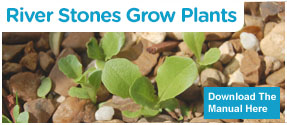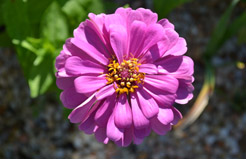FOOD FROM ROCKS? GRAVEL GARDENING

So, you might not be able to get blood out a rock, but if it’s the right rock, it will give you food. Sound pretty crazy? It seems it isn’t. Plant science departments have been investigating this for a while, and it definitely has merit. A study was done at Tennessee State University of growing 37 types of vegetable seeds in gravel versus soil, and found the plants grew better in gravel than soil. Not surprising given that hydroponics is more efficient than soil. The amazing part is the absence of nutrient input.
“This is truly a significant step for plant sciences.” Professor Arvazena Clardy Ph.D., Assistant Professor of Horticulture at Tennessee State University
Like many discoveries, this new and patented growing method came about by accident. A watermelon seed spit out on the patio one summer sprouted the next and grew like crazy. Curious about this event, the guy started purposefully planting in the gravel to see what happened. Plants grew without fail, and flourished. It made no sense. They couldn’t access soil because there was a layer of landscape fabric stopping weeds from growing and preventing the gravel from being lost to the soil. Where were the plants getting food from?
From the rocks themselves. Rock does have nutrients in it, as long as it is sedimentary. That’s why organic gardeners add rock dust to their soil – it’s a slow release form of mineral fertilization. Nutrients that are trapped in the rock are made available to the plants by water. Taking it one step further, the expanded clay pellets or hydroton used in hydroponic and aquaponic gardening was selected for being inert, or having no nutrient content at all. Why? Because any available nutrient in your growth media will mess up the balance of your nutrient solution – just as minerals in your water can throw off both pH and EC levels. They do use gravel in aquaponics, but it is different from hydroponics since the nutrient comes from the fish waste, instead of scientific formulated dilution of nutrient additives in water.
So… What is sedimentary gravel?
Small stones formed by deposits of organic sediment and mineral sand that are crushed together by surface activity like rivers, glaciers, and environmental events. There are all kinds of things in organic sediment that one adds back to soil in organic gardening: plant debris (compost or humus), fish and animal sediment (blood meal, fish emulsion, worm castings, manure), minerals (rockdust, phosphate), and micronutrients (copper, boron, magnesium, etc).
What they have discovered is that water causes the nutrients and minerals in sedimentary rock to leach out and become available to the plants. It’s not an instant thing. But that’s not bad, in fact it’s safer nutrition for plants than “hot” fertilizers with high analysis like 14-14-14. Organic fertilizers will appear to be weak to gardeners used to chemical fertilizers, because the analysis always has small numbers – far smaller than even the worry-free 10-10-10 analysis of popular fertilizers like Miracle Gro. But organic fertilizers are generally slow-and-steady sources of nutrients, while chemical fertilizers are fast release (unless polymer-coated to release over time).
Geological agriculture is a form of hydroponics.
First, it is soilless – no peat moss, coir, compost, perlite – nothing that mimicks soil in use at all. Second, the nutrients are made available through water. There are no pumps or solution tanks. The cotton fabric moves water around the growing bed like a wicking mat or string would in passive hydroponics. The sand is sort of your reservoir, holding water that is readily available on demand below the gravel growth media that only needs replenishing once a week or so… even outdoors in summer temperatures.
Just as you find in the landscape, only the top surface of rocks and stone is hot and dry. The density of the material allows it to shade the lower portions, and block wind and sun from removing all moisture. And then there’s the texture of gravel that is an asset. It allows excellent oxygen availability to roots, and never compacts. Water readily drains off the surface and leaves the root zone, so the danger of it being too wet is never an issue.
The guy who discovered this, Richard Campbell, has done a lot of research on what makes it possible. He’s had studies done at TSU and George Washington University on the growing method, which has been in development since 2008, and was patented in the U.S. last fall.
Dr. H. Henry Teng of the Chemistry Department at GWU examined the geological side of this science. He compared the microscopic surface area of fresh gravel against gravel used in growing crops for years. What were the results of his research? I haven’t read the book yet, but he’s quoted as saying, “I hope more people learn gardening in gravel technique.” The book? There’s actually a series of them. Campbell has written a book about gardening in gravel each year, which while may have similarities to one another, have evolved along with the method itself. The 2014 edition of this “Study of Geological Agriculture” is available in print on Amazon, but the newest one for 2016 is only available on his website, To Soil Less, as a download. He was recently interviewed by Sustainable Brands, and here’s some quotes from that source:
“Earth’s natural nutrients within sedimentary rock enable a nutrient transfer from rock, to the water, to the seed and roots,” Campbell explained. “Sedimentary rock, river rock or pea gravel releases, among other things, potassium, silica and copper when impacted with water. Each of these components provides a nutrient cocktail for plants naturally. Combined with air, sunlight, water and nitrogen fixation, you have a permanent growing ecosystem.”
“Geological agriculture is humanity’s first new science since IT,” Campbell said. “We only know 2 percent of the power embedded within sedimentary materials. Mankind has studied soil for thousands of years but not rocks.”
Indeed. It’s definitely got my curiosity up. A new experiment! That’s what summer is for 😉
Learn more:
- Could Growing Food in Gravel Be Pay Dirt for Sustainable Agriculture?
- 2014 Study of Geological Agriculture (** good reading on the Peek Inside)
- 2016 Study of Geological Agriculture (digital only)
- U.S. Patent #9,119,351
- Oklahoma State University






